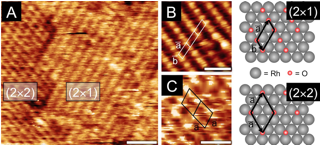Reports: DNI557440-DNI5: Surface structures of Rh and Ag at high oxygen coverages
Daniel R. Killelea, PhD, Loyola University of Chicago
Support from the PRF has enabled advances in understanding
the formation of subsurface oxygen (Osub) on Rh(111) and Ag(111),
and structures on the oxidized surfaces under conditions of high oxygen coverages.
On both Ag(111) and Rh(111), the surface becomes saturated with O, but
additional oxygen atoms can For the rhodium study, a clean Rh(111) crystal was exposed
to oxygen under ultra high vacuum (UHV) conditions; the oxygen coverage ( We have also studied a catalytically active surface,
Ag(111), where extensive reconstruction occurs upon deposition of O atoms. We
have focused on how subsurface O can be formed on Ag(111), and how the
structure of the surface oxide may be perturbed when the selvedge is populated
with O atoms. Ag(111) was exposed to gas-phase O atoms in UHV, and the
resultant surfaces were studied with a combination of AES, TPD, LEED, and STM. Figure
3 shows TPD spectra for various exposures (Figure 3A and B) and a plot of the
integrated TPD peak vs. the relative O surface coverage (Figure 3C). The
temperature of the filament used to create atomic oxygen has a dramatic effect
on the state of the oxidized surface. When Tfil = 1750 K, the
expected surface oxides corresponding to the Additionally, the surface structures under several 















